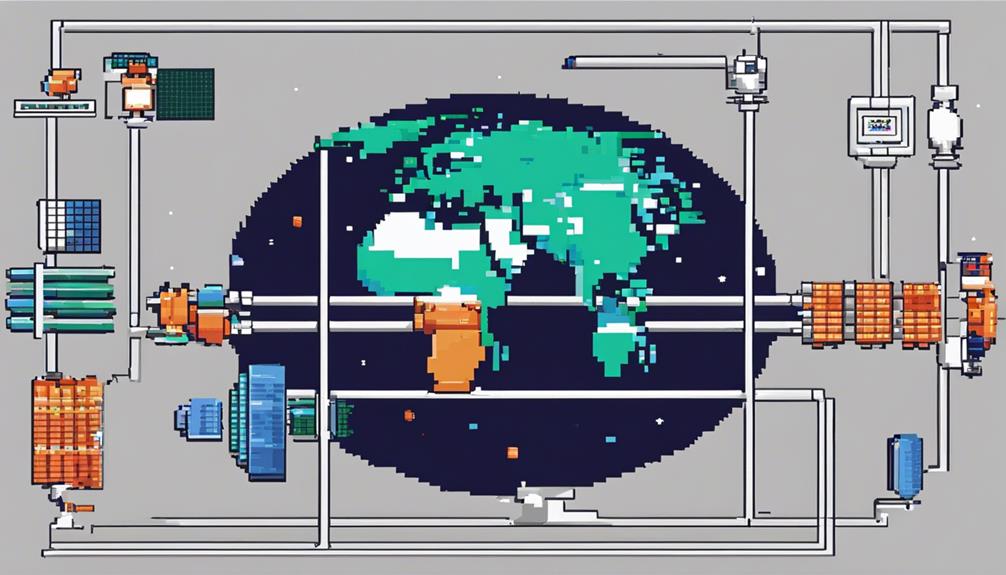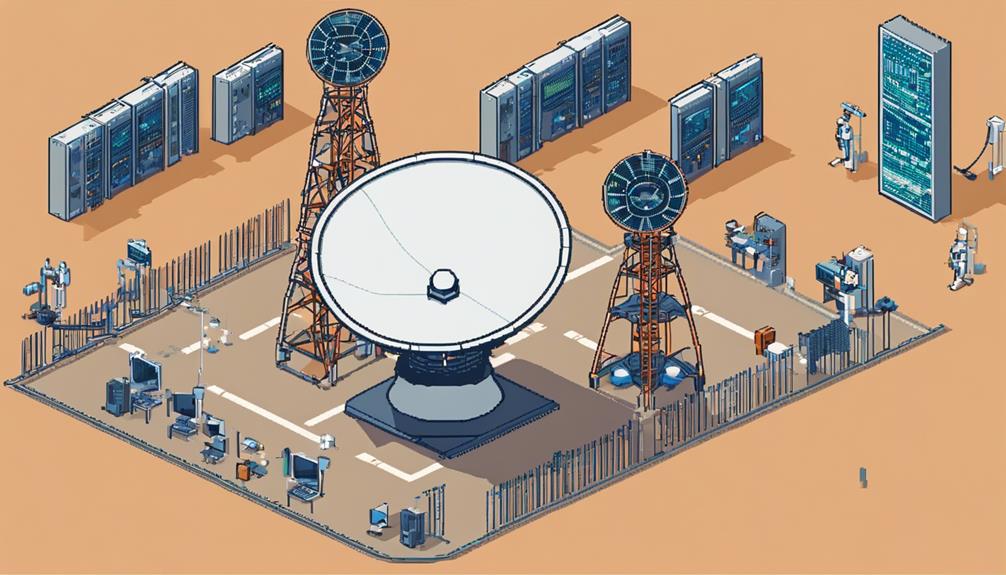In the intricate realm of satellite communication protocols and ground stations, the orchestration of data transmission and reception unfolds with meticulous precision. From the standards governing satellite-to-ground station interactions to the intricate web of connectivity technologies employed, every aspect resonates with technical intricacies. As we delve into the intricate web of secure data transmission methods, error correction mechanisms, and satellite command protocols, the groundwork laid by ground station network configurations and telemetry monitoring systems emerges as the backbone of this interconnected network. Antenna technologies further amplify the significance of these stations in ensuring seamless communication.
Key Takeaways
- Utilize TCP/IP and UDP for reliable and real-time data transfer in satellite communication.
- Implement encryption and authentication protocols for secure data transmission.
- Employ ground station connectivity technologies like RF, fiber optic, and microwave links for efficient data transfer.
- Adhere to satellite command protocols and authentication methods for secure control of satellite functions.
Communication Protocols Overview

In the realm of satellite communication, the intricate network of Communication Protocols plays a pivotal role in orchestrating the seamless exchange of data between ground stations and satellites. Communication protocols such as TCP/IP, UDP, and DVB-S2 are essential for efficient data transmission. TCP/IP, a widely used protocol suite, ensures reliable and ordered delivery of data packets between connected devices. UDP, on the other hand, is preferred for real-time applications due to its low latency and connectionless nature. DVB-S2, specifically designed for satellite communication, optimizes bandwidth utilization and error correction mechanisms.
These communication protocols govern how data is formatted, transmitted, and received, ensuring secure and reliable communication. By defining rules for packet structuring, error detection, and correction, these protocols enable ground stations to establish robust connections with satellites. Additionally, protocols like CCSDS standardize data exchange formats, promoting interoperability among different satellite systems. This standardization simplifies data sharing and processing between various satellites and ground stations.
Satellite-to-Ground Station Standards
Establishing seamless communication between satellites and ground stations relies on adherence to standardized protocols such as CCSDS, ensuring reliable data exchange. The Consultative Committee for Space Data Systems (CCSDS) plays a pivotal role in shaping the standards for satellite-to-ground station communication. These standards define the formats, procedures, and protocols necessary for effective data exchange and synchronization between satellites and ground stations. Compliance with CCSDS standards is essential to enable interoperability and smooth communication in the space industry.
Satellite-to-Ground Station Standards Table:
| Aspect | Description | Importance |
|---|---|---|
| Telemetry | Involves collecting and transmitting data from satellites to ground stations for analysis. | Vital for monitoring |
| Telecommand | Enables ground stations to send commands to satellites for various operations and tasks. | Essential for control |
| Data Exchange | Defines how data is structured, formatted, and exchanged between satellites and ground stations. | Critical for communication |
| CCSDS Standards | Guidelines set by CCSDS for satellite communication, ensuring uniformity and reliability. | Fundamental for consistency |
Adhering to established standards like CCSDS is fundamental for promoting efficiency, compatibility, and reliability in satellite-to-ground station communication. These standards cover crucial aspects such as telemetry, telecommand, and data exchange, providing a robust framework for the seamless integration of satellite systems with ground stations.
Secure Data Transmission Methods

Secure data transmission methods are critical in ensuring the confidentiality and integrity of data exchanged between ground stations and satellites. Encryption plays a vital role in data security, while authentication techniques verify the identities of users and devices involved in the communication process. Implementing secure transmission protocols enhances the overall protection of sensitive information during satellite communication operations.
Encryption for Data Security
Data security in satellite communication is ensured through the use of encryption protocols that safeguard the confidentiality and integrity of transmitted information. Encryption methods employed in ground stations utilize algorithms such as the Advanced Encryption Standard (AES) to secure data during transmission. Common encryption protocols like Secure Socket Layer (SSL) and Transport Layer Security (TLS) are essential for maintaining data security. By encrypting the data exchanged between satellites and ground stations, unauthorized access to sensitive information is prevented. These encryption techniques play a crucial role in ensuring the confidentiality and integrity of data as it travels between different points in the satellite communication network, providing a secure means of transmitting information across vast distances.
Authentication Techniques Used
Authentication techniques employed in ground stations encompass a range of encryption algorithms, including AES and RSA, to ensure the secure transmission of data. These methods are crucial in safeguarding sensitive information from cyber threats and potential data breaches. In addition to encryption algorithms, ground stations commonly utilize two-factor authentication to verify user identities before granting access to critical data. Biometric authentication measures, such as fingerprint or iris scans, are also implemented to add an extra layer of security against unauthorized access attempts. Furthermore, the deployment of SSL/TLS protocols establishes secure communication channels between ground stations and satellites, enhancing the overall cybersecurity posture of satellite communication systems.
Secure Transmission Protocols
Utilizing advanced encryption standards and secure key exchange protocols, satellite communication systems ensure the confidentiality and integrity of transmitted data. Encryption protocols such as AES and SSL/TLS are commonly employed to secure data transmission over satellite links. Algorithms like RSA and ECC play a vital role in establishing secure communication channels between ground stations and satellites. Key exchange protocols like Diffie-Hellman facilitate the secure exchange of encryption keys, enhancing the overall security of data transmission. Additionally, hash algorithms like SHA-256 are instrumental in verifying data integrity and preventing unauthorized tampering during communication. By implementing secure tunneling protocols such as VPN, satellite communication networks create secure channels over public networks, safeguarding the confidentiality of data exchanged between ground stations and satellites.
Ground Station Connectivity Technologies

Ground stations leverage a variety of connectivity technologies, such as RF communication, fiber optic links, and microwave links, to facilitate satellite communication efficiently and reliably. These technologies play a crucial role in establishing robust communication links between ground stations and orbiting satellites.
- RF Communication:
- RF communication is a widely used technology in satellite communication due to its reliability and ability to penetrate various atmospheric conditions. It provides a stable connection for data transfer between satellites and ground stations.
- Fiber Optic Links:
- Fiber optic links offer high data transfer rates and low latency, making them ideal for transmitting large volumes of data quickly and efficiently. Ground stations benefit from the speed and reliability of fiber optics in handling satellite communication.
- Microwave Links:
- Microwave links enable point-to-point communication with high bandwidth capabilities, facilitating rapid and seamless data transmission between ground stations and satellites. These links are essential for ensuring continuous and uninterrupted satellite communication.
Satellite Command Protocols
Satellite command protocols dictate how ground stations interact with satellites, facilitating critical tasks such as orbit adjustments and payload operations. Within these protocols lie essential features like Protocol Authentication Methods and Error Handling Procedures, ensuring secure and reliable communication between ground control and the satellite. By adhering to established standards like CCSDS, these protocols play a fundamental role in overseeing satellite functions and safeguarding mission objectives.
Protocol Authentication Methods
Authentication methods are essential components in ensuring the secure and legitimate control of satellite functions through ground stations. Secure authentication protocols play a critical role in maintaining the integrity and security of satellite operations. Common methods used for authenticating commands in satellite communication services include:
- Password-based authentication
- Digital signatures
- Encryption techniques
These methods help prevent unauthorized access and ensure that only authorized users can interact with the satellite systems, safeguarding against potential tampering or malicious activities. By incorporating these secure authentication protocols, the satellite communication network can operate efficiently and securely, maintaining the confidentiality and reliability of satellite operations.
Error Handling Procedures
Error handling procedures within satellite command protocols involve the systematic detection, identification, and resolution of communication errors to ensure the reliability and accuracy of data transmission. Ground stations utilize error correction codes such as checksums to validate and correct data, enhancing the integrity of the transmitted information. Error detection techniques like cyclic redundancy checks aid in identifying errors within the data packets exchanged over satellite communication links. In cases where errors are detected, retransmission protocols come into play, allowing for the request and recovery of missing or corrupted data packets to maintain the continuity of communication. Moreover, error recovery procedures may be initiated at ground stations to uphold the robustness of satellite communication links and ensure seamless data transmission.
Real-Time Data Processing Systems

Real-time data processing systems in satellite ground stations efficiently manage and analyze large volumes of data with millisecond precision. These systems play a critical role in handling satellite data effectively, ensuring seamless communication and enabling rapid responses in emergency situations. Key aspects of real-time data processing systems include:
- Advanced Algorithms: Real-time data processing systems leverage sophisticated algorithms to swiftly process and analyze vast amounts of satellite data. These algorithms are designed to optimize the efficiency and accuracy of data processing tasks.
- Immediate Response: By processing satellite data in real-time, these systems enable ground stations to promptly respond to satellite commands and data requests. This instantaneous response is essential for maintaining continuous and reliable communication with satellites.
- Decision Support: Real-time data processing systems facilitate quick decision-making based on the latest satellite information. This capability is particularly crucial for time-sensitive applications such as emergency response and disaster management, where swift and informed decisions can have a significant impact on outcomes.
Emergency Communication Procedures
In emergency communication procedures at satellite ground stations, swift response and efficient data transmission are paramount priorities. During critical situations such as natural disasters or emergencies, ground stations are crucial in ensuring rapid and effective communication. These procedures involve monitoring distress frequencies, activating emergency beacons, and coordinating rescue operations with relevant authorities. Ground stations serve as the primary point of contact for receiving distress signals and initiating response actions.
Emergency communication protocols are designed to facilitate seamless coordination between ground stations, satellites, and emergency response teams. By relaying real-time information and coordinating rescue efforts, ground stations play a vital role in supporting rescue operations and providing timely assistance to those in need. In times of crisis, the ability to quickly transmit data and communicate effectively can make a significant difference in the outcome of emergency situations.
Satellite Tracking and Navigation Tools

Utilizing sophisticated satellite tracking and navigation tools is essential for ensuring precise positioning and alignment of satellites in orbit. Ground stations play a crucial role in tracking satellites by utilizing advanced tools and techniques. Some key elements involved in satellite tracking and navigation tools include:
- Two Line Elements (TLE): These elements are vital for describing the orbital parameters of satellites accurately. TLE data provides essential information for ground stations to determine the satellite's position and predict its future path in orbit.
- Antenna Tracking Systems: Ground stations integrate specialized software to determine the optimal orientation of antennas for tracking satellites. Antenna tracking systems use closed-loop control mechanisms, including sensors and actuators, to maintain precise alignment with the satellite as it moves across the sky.
- Orbital Propagators: Ground stations utilize orbital propagators to estimate the positions of satellites accurately. By calculating azimuth and elevation commands based on predicted satellite locations, ground stations can adjust their antennas to track satellites more effectively.
These tools and technologies are fundamental in the field of satellite tracking and navigation, enabling ground stations to monitor and communicate with satellites in orbit with precision and efficiency.
Ground Station Signal Reception Techniques
Ground station signal reception techniques encompass a detailed analysis of antenna types optimized for signal reception and the sophisticated signal processing methods employed. The selection of high-gain antennas plays a crucial role in enhancing the efficiency of signal reception from satellites. Additionally, ground stations rely on advanced signal processing techniques to extract, decode, and ensure the accuracy and reliability of data transmitted by satellites.
Antenna Types for Reception
Among the various antenna types used in ground station signal reception techniques, parabolic antennas are widely favored for their high-gain capabilities. They excel in capturing weak signals from distant satellites. Additionally, other antenna systems used for reception include:
- Yagi antennas: Offering directional reception, ideal for specific satellite tracking requirements.
- Helical antennas: Providing circular polarization to enhance signal reception in ground stations.
- Patch antennas: Compact and lightweight options suitable for limited space installations.
Each of these antenna types serves specific purposes in satellite communication, catering to different signal reception needs in ground stations. The choice of antenna depends on factors such as the satellite's position, signal strength, and required coverage.
Signal Processing Methods
In the realm of satellite communication, signal processing methods play a pivotal role in enhancing the quality and reliability of ground station signal reception techniques. Ground stations employ various signal processing techniques such as demodulation and error correction to improve the accuracy of received signals. Filtering is used to eliminate noise and improve signal quality, while techniques like carrier recovery help in extracting frequency and phase information accurately. Additionally, matched filtering algorithms are crucial for detecting and extracting the desired signal amidst noise and interference. Adaptive equalization is also employed to counteract signal distortion during transmission, ensuring optimal signal reception. These sophisticated signal processing methods are essential for efficient and effective communication between satellites and ground stations.
Data Encryption and Decryption Methods

Utilizing sophisticated algorithms, data encryption plays a pivotal role in safeguarding sensitive information during transmission within satellite communication protocols. Ground stations implement various encryption techniques to ensure the security of data exchanged with satellites. Some key points to consider include:
- Advanced Encryption Standards (AES): AES is a widely used encryption standard in satellite communication protocols. With key lengths of 128, 192, or 256 bits, AES provides robust encryption to protect data from unauthorized access.
- Decryption Methods: Ground stations employ decryption methods to reverse the encryption process and convert ciphertext back to plain text. This allows authorized personnel to access the original data securely.
- Public Key Infrastructure (PKI): PKI is essential for establishing a secure key exchange mechanism between ground stations and satellites. It enables encrypted communication by managing digital certificates and keys effectively.
In addition to these methods, protocols like Secure Socket Layer (SSL) and Transport Layer Security (TLS) are implemented for secure data transmission between ground stations and satellites. By adhering to stringent encryption standards and employing efficient decryption techniques, ground stations can ensure the confidentiality and integrity of data transmitted over satellite communication links.
Error Correction Mechanisms
Ground stations rely on error correction mechanisms within satellite communication protocols to ensure the accuracy and integrity of data transmitted over satellite links. Error correction mechanisms are essential for detecting and correcting errors that may occur during data transmission, thereby maintaining data integrity. These mechanisms employ various techniques such as error correction codes and redundancy to enhance the quality of communication.
Error correction codes, such as Reed-Solomon codes and convolutional codes, are commonly used in satellite communication protocols to add redundancy to the transmitted data. Redundancy allows the receiver to detect and correct errors that may have occurred during transmission, ensuring the accuracy of the received data. Forward Error Correction (FEC) techniques are particularly effective in satellite communication, as they enable the receiver to correct errors without the need for retransmission.
Error correction mechanisms not only focus on error detection but also play a crucial role in error correction. By implementing these mechanisms, satellite communication systems can overcome the challenges posed by communication channels affected by noise, interference, or signal degradation. Ultimately, error correction mechanisms contribute significantly to maintaining the quality of communication in satellite networks, ensuring reliable and accurate data transmission.
Ground Station Network Configurations

Ground station network configurations encompass various station types and network connectivity options. Understanding the types of ground stations and how they are interconnected is crucial for optimizing satellite communication efficiency. Network connectivity plays a vital role in ensuring seamless data transmission and communication reliability across the satellite network.
Station Types
Station Types in satellite communication networks are crucial components that play distinct roles in ensuring efficient and reliable communication links. Ground station network configurations encompass a variety of station types, including:
- Telemetry, Tracking, and Command (TT&C) stations for satellite control.
- Remote sensing ground stations responsible for data reception and processing for Earth observation satellites.
- Teleport ground stations facilitating data transmission for broadcasting and telecommunications satellites. These station types are essential for managing satellite missions effectively. Ground stations are often classified as primary, backup, or redundant stations to ensure operational reliability based on the specific communication needs of the satellite network.
Network Connectivity
In the realm of satellite communication networks, the foundation for seamless and reliable operations lies in the intricate web of network connectivity through ground station configurations. Ground station network configurations can range from simple point-to-point connections to intricate global networks, ensuring data, signal, and control flow between terrestrial networks and satellite networks. These networks often interconnect multiple ground stations using various protocols like TCP/IP, UDP, and SNMP for efficient communication and management. Advanced technologies such as MPLS are integrated into modern ground station networks to optimize data routing and Quality of Service (QoS) management. Redundant configurations are paramount, guaranteeing uninterrupted communication in the face of equipment failures or network disruptions.
| Network Component | Description | Purpose |
|---|---|---|
| Ground Stations | Physical locations that receive and transmit signals to satellites | Interface with satellites |
| Terrestrial Networks | Earth-based communication networks linked to ground stations | Connect ground stations globally |
| Data Transmission | Transfer of information between ground stations and satellites | Ensure seamless communication |
Satellite Telemetry Monitoring Systems
Satellite telemetry monitoring systems play a critical role in collecting real-time data on satellite health, performance, and position. These systems are essential for ensuring the proper functioning of satellites in orbit. The telemetry data received from satellites includes crucial information such as power levels, temperatures, and subsystem operations. This data is transmitted from sensors onboard the satellites to ground stations for monitoring and analysis.
- Ground stations receive telemetry data from satellites.
- Telemetry data provides insights into satellite health and performance.
- Monitoring subsystem operations is integral for optimizing satellite functionality.
Ground stations process and analyze the telemetry data to monitor the satellite's performance continuously. By tracking various parameters, ground stations can detect any anomalies, diagnose issues promptly, and take necessary actions to optimize the satellite's performance. Monitoring satellite telemetry is vital for ensuring that the satellite operates within specified parameters and functions effectively in space. It enables operators to make informed decisions to maintain the satellite's health and longevity.
Ground Station Antenna Technologies

Ground station antenna technologies, including parabolic antennas, phased array antennas, and flat panel antennas, are integral components in satellite communication systems for ensuring efficient signal transmission and reception. Parabolic antennas are favored for their high gain and directionality, making them ideal for both sending and receiving signals in satellite communication. Phased array antennas, on the other hand, offer advanced capabilities such as electronic beam steering, enabling rapid signal tracking and the ability to create multiple beams for communication purposes. This technology enhances the agility and flexibility of communication systems. Flat panel antennas, known for their compact and lightweight design, are suitable for applications requiring low-profile installations and agile beamforming, contributing to the efficiency of communication processes. These antenna technologies are crucial in establishing reliable and effective communication links between ground stations and satellites in various orbital configurations, ensuring seamless data transmission and reception. By leveraging the strengths of each type of antenna technology, satellite communication systems can achieve optimal performance in efficiently handling data exchange between ground stations and satellites.
Frequently Asked Questions
How Do Satellites Communicate With Ground Stations?
Satellites communicate with ground stations through a complex process involving antenna alignment, signal modulation, data transfer, frequency bands, signal reception, weather interference, and power supply. Antennas on satellites and ground stations must be precisely aligned to establish a strong communication link. Signal modulation techniques are employed to encode data for transmission. Different frequency bands are used for communication. Signal reception is crucial for accurate data transfer, while weather interference and power supply stability impact communication quality.
What Protocols Are Used in Satellite Communication?
Satellite communication protocols encompass a range of standards and technologies vital for seamless data transmission. From the selection of appropriate frequency bands to the intricacies of data encoding, error correction, and modulation schemes, each aspect plays a crucial role in ensuring reliable communication. Signal processing, antenna design, and meticulous link budgets further optimize performance. This intricate interplay of elements harmonizes to establish robust satellite communication protocols essential for modern connectivity needs.
What Are the Types of Earth Station in Satellite Communication?
In satellite communication networks, earth stations serve crucial roles such as telemetry, tracking, and command, gateway services, direct communication with satellites, and mobile communication. These stations are equipped with advanced antenna technology for signal reception and transmission across various frequency bands. Signal processing capabilities, tracking systems for satellite positioning, reliable data transmission mechanisms, robust power supply systems, and resilience to varying weather conditions are essential features of earth stations to ensure seamless satellite communication operations.
What Are the Requirements for Satellite Ground Station?
Satellite ground stations require meticulous planning and execution to meet operational demands. Antenna positioning is critical for optimal signal reception, while reliable power supply ensures continuous operation. Data transmission necessitates robust security measures to safeguard sensitive information. Weather monitoring enhances station resilience, and regular equipment maintenance is imperative for sustained performance. Remote monitoring capabilities provide real-time oversight for efficient troubleshooting and management. These requirements collectively ensure the smooth functioning of satellite ground stations.
